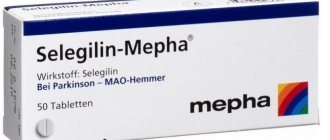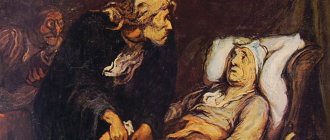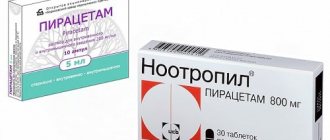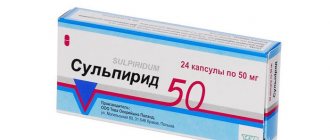What is syncope in adults?
In medical terminology, syncope, fainting or syncopal syndrome is a short-term loss of consciousness, which is accompanied by a drop in muscle tone. The causes of the condition are called transient hypoperfusion of the brain. Symptoms of an attack include pale skin, hyperhidrosis, inactivity, low blood pressure, cold extremities, weak pulse and breathing. After syncope, the patient recovers quickly, but feels weak and fatigued, and sometimes retrograde amnesia is possible.
ICD-10 code
Syncope in medicine has its own classification with letter and code designation. Thus, the general group of fainting and collapse R 55 is divided into the following syncope subtypes:
- psychogenic conditions;
- sinocarotid syndromes;
- heat syncope;
- orthostatic hypotension;
- neurogenic conditions;
- Stokes-Adams syncope.
https://www.youtube.com/watch?v=ytaboutru
According to statistics, half of the adult population has experienced syncope once. Only 3.5% go to the doctor. The reason for a visit to a medical facility is likely to be injuries sustained in a fall. 3% of emergency surgery patients complained of recurrent seizures. Special studies have found undiagnosed syncope in 60% of adult subjects.
Fainting can occur in young people of both sexes aged 17-32 years. Any healthy person in extreme conditions can fall unconscious, since physiological capabilities have their own adaptation limits.
Doctors do not recommend throwing yourself into cold water, since there is a danger of a terminal condition - drowning, but not from filling the lungs with water, but due to a coronary attack, blocking cerebral circulation. If the victim is pulled out of the water in time (no later than 5-6 minutes), he can be resuscitated.
What is syncope and its neurological assessment
Syncope can occur at any age. Usually occurs while sitting or standing. Caused by acute brainstem or cerebral oxygen starvation.
Syncope must be distinguished from acute cerebrovascular accident. In the first case, spontaneous recovery of cerebral functions is observed without the manifestation of residual neurological disorders.
Neurologists distinguish between neurogenic and somatogenic syncope.
The classification of syncope is very complex. They are distinguished according to pathophysiological principles. It should be noted that in a significant number of cases the cause of syncope cannot be determined. In this case, they speak of idiopathic syncope syndrome.
The following types of syncope also differ:
- Reflex. These include vasovagal and situational fainting.
- Orthostatic. They arise due to insufficient autonomic regulation, taking certain medications, drinking alcoholic beverages, and hypovolemia.
- Cardiogenic. The cause of syncope in this case is cardiovascular pathology.
- Cerebrovascular. Occurs due to blockage of the subclavian vein by a thrombus.
There are also non-syncope pathologies, but they are diagnosed as syncope. Complete or partial loss of consciousness during a fall occurs due to hypoglycemia, epilepsy, poisoning, and ischemic attacks.
There are non-syncope states without loss of consciousness. These include short-term muscle relaxation due to emotional overload, panic attack, pseudosyncope of a psychogenic nature, as well as hysterical syndromes.
Post-syncope state
Syncope, what it is and what types it is divided into, was determined by the European Society of Cardiology.
| Type of syncope | Internal deviations | Provoking factor |
| reflex | drop in blood pressure, bradycardia, impaired cerebral microcirculation | sharp sound, severe pain, surge of emotions, cough, rapid turn of the head, pressing collar |
| orthostatic collapse (orthostatic hypotension) | life-threatening condition - a sharp drop in pressure in the arteries and veins, depression of metabolism, inhibition of the reaction of the heart, blood vessels, nervous system to prolonged standing or rapid changes in body position | long periods of standing on your feet in exhausting conditions (heat, crowded conditions, holding a load), changing posture from horizontal to vertical, taking certain medications, Parkinson's disease, brain cell degeneration |
| cardiac (arrhythmia) | insufficient blood ejection due to atrial flutter and fibrillation, ventricular tachycardia, complete transverse block | heart pathology |
| cardiopulmonary | discrepancy between the circulatory needs of the body and the capabilities of the heart | narrowing of the pulmonary artery, increased pressure in the bloodstream from the heart to the lungs, benign neoplasm in the heart (myxoma) |
| cerebrovascular | changes in cerebral vessels, leading to insufficient blood supply to the brain and damage to its tissues | deficiency of blood flow from the basilar (in the brain) and vertebral arteries, steal syndrome (ischemia from a sharp lack of blood in the organ) |
In ICD-10, syncope and collapse are combined by code R55.
During clinical studies, cardiologists, neurologists, and other specialists were unable to determine the true cause of fainting and its recurrence in 26% of subjects. A similar picture emerges in practice, which complicates the choice of treatment.
This is explained both by the episodic nature of precedents and by the variety of trigger mechanisms:
- diseases of the heart and blood vessels;
- acute short-term decrease in blood flow to the brain;
- increased excitability of the vagus nerve, which controls the muscles of the respiratory, speech, cardiac, and digestive apparatus;
- cardiac arrhythmia;
- decreased glucose levels in the bloodstream;
- damage to the glossopharyngeal nerve;
- infectious diseases;
- psychical deviations;
- hysterical fits;
- head injuries;
- fatigue;
- hunger.
When characteristic warning signs of fainting appear, you need to lie down straight and raise your legs. This will ensure blood flow to the heart and head. Unbutton the clothes that are constricting your chest, massage the point above your upper lip and temples.
If you lose consciousness before the doctors arrive, those around you can help with the following actions:
- they pick up a limp man;
- lay flat, legs raised, head turned to the side so that the tongue does not block air access;
- open the windows, turn on the fan, free the chest from clothing;
- They give you ammonia to smell, they slap you on the cheeks, splash you with cold water, and rub your ears.
Factors in the occurrence of syncope include various pathologies - cardiac, neurological, mental diseases, metabolic and vasomotor disorders. The main cause of fainting is sudden transient cerebral hypoperfusion - a decrease in cerebral blood flow.
- state of vascular wall tone;
- blood pressure level;
- heart rate;
- myocardial infarction, ventricular fibrillation, tachycardia;
- taking vasoactive drugs;
- autonomic neuropathies, problems with neurology;
- ischemic strokes, migraines, hemorrhages;
- diabetes;
- elderly age.
In children
Syncope in children manifests itself for similar reasons as in adults, plus child-specific ones are added:
- standing in one place for a long time in stuffy conditions without oxygen;
- feeling of fear at the sight of injections;
- strong excitement from the sight of blood, fear;
- rarely clinical causes include sneezing, coughing, laughing, urination, defecation, physical stress;
- prolonged stay in bed, dehydration, bleeding, taking certain medications;
- sharp sounds;
- heart defects.
According to the pathophysiological mechanism, fainting conditions are classified according to the following scheme:
- Neurogenic syncope - reflex, vasovagal, typical, atypical, situational when sneezing or coughing, with trigeminal neuralgia.
- Orthostatic - caused by a lack of autonomic regulation, with secondary insufficiency syndrome, post-exertion, postprandial (after eating), caused by medications, alcohol intake, diarrhea.
- Cardiogenic syncope - arrhythmogenic, caused by disruption of the sinus node, tachycardia, rhythm disturbance, functioning of defibrillators, due to the action of medications, diseases of the cardiovascular system and arteries.
- Cerebrovascular - due to a sharp narrowing or blockage of the subclavian vein.
- Non-syncope with partial loss of consciousness - they can be caused by metabolic disorders, epilepsy, intoxication, ischemic attacks.
- Non-syncope without loss of consciousness - cataplexy, pseudosyncope, panic attacks, ischemic conditions, hysterical syndrome.
Vasodepressor syncope occurs due to disruption of the heart and begins with an increase in tone and an increase in pressure. Orthostatic fainting is common in older people and is caused by instability of vasomotor function. Every fifth syndrome is cardiogenic, occurring due to a decrease in stroke volume of the heart. Cerebrovascular conditions occur due to hypoglycemia and medications.
After recovering from fainting, patients fall into a post-syncope state. It lasts from several seconds to hours and is characterized by weakness, headache, and excessive sweating. If a person is prone to fainting, they may lose consciousness again during this time. Between syncope attacks, patients experience asthenodepressive manifestations and autonomic reactions.
Causes of syncope with low blood pressure
Hypotension (low blood pressure) is the main cause of syncope, dizziness and drowsiness. In people suffering from low blood pressure, the processes of vasoconstriction and dilation occur more slowly than normal.
Due to oxygen starvation, internal organs and systems are not able to function normally. In this case, poor circulation and abnormal vascular tone lead to weakening of the body.
To what level should blood pressure (BP) drop sharply for a person to lose consciousness?
- with normal blood pressure, the tonometer readings are 120/80 mm Hg. Art.;
- slightly reduced blood pressure – 90/60 – 115/70;
- if the lower reading sharply decreases by more than ten mmHg. Art., and the upper one - by twenty mm Hg. Art., fainting may occur.
Loss of consciousness in a situation of low blood pressure is a common phenomenon that is experienced by all categories of the population, regardless of age and diagnosis.
Factors causing syncope with hypotension:
- pain shock;
- severe blood loss;
- sudden adoption of a vertical position;
- taking medications that affect blood pressure levels;
- diseases of the cardiovascular system;
- brain diseases;
- diabetes;
- dehydration;
- overheating of the body;
- pregnancy;
- stress, overwork, depression;
- infection, allergy;
What types of fainting occur with low blood pressure?
Low blood pressure contributes to the following types of syncope:
- anemic - occurs due to a significant decrease in hemoglobin content in the blood due to iron deficiency, blood loss, vitamin deficiency;
- situational - caused by physical overexertion, urination, diving or coughing due to increased intrathoracic pressure;
- vasovagal - is the body’s reaction to stress (fear, pain, hemophobia, etc.). Half of all syncopes belong to this type of syncope.
Symptoms
It is necessary to distinguish between short-term fainting and prolonged loss of consciousness. If a person does not come to his senses for more than 5 minutes, this suggests, for example, a stroke from a ruptured vessel or blood clot. The patient may slowly come to his senses with amnesia, or may fall into a coma.
If syncope lasts for a very long time, it may be due to a stroke or other serious causes.
If the attack lasts 1-2 minutes. – this is a slight fainting, up to 3 minutes. - heavy.
Symptoms of fainting are systematized as follows:
- Preceding signals: weakness, dizziness; floaters, trembling reticle or darkening of the eyes; noise, ringing, squeaking in the ears; looseness in the limbs;
- Syncope: sharp paleness; wandering unconscious gaze or closed eyes; the pupils are initially constricted and dilate without responding to light stimuli; the body goes limp and falls; limbs become cold, cold sticky sweat covers the entire area of the skin; the pulse is weak or cannot be felt; breathing is shallow, slow;
- Post-syncope state: rapid return of consciousness (if the cardiovascular system is normal and there is no damage from a fall); restoration of blood circulation, normal breathing, heart rate, color of the integument; weakness and malaise disappearing after a few hours.
Depending on the type of manifestation of syncope, the following characteristic symptoms are distinguished:
- Vasodepressor syncope or vasovagal state - manifested by weakness, nausea, cramping abdominal pain. The attack can last up to 30 minutes.
- Cardiogenic conditions - before them the patient feels weakness, rapid heartbeat, chest pain. They account for the bulk of syncope in older people.
- Cerebrovascular syncope - ischemic attack, rapid loss of consciousness, general weakness, dizziness, impaired visual acuity.
When fainting, the patient’s consciousness turns off suddenly, but sometimes it may be preceded by a prefainting state, in which the following are observed:
- severe weakness;
- dizziness;
- noise in ears;
- numbness of the limbs;
- darkening of the eyes;
- yawn;
- nausea;
- pale face;
- convulsions;
- sweating
Causes and triggers of vasovagal syncope
Vasovagal syncope occurs when something triggers the vasovagal reflex, causing the blood vessels to suddenly dilate. The dilation of blood vessels causes a significant portion of the blood volume to accumulate in the legs.
This association is often accompanied by a slowing of the heart rate. As a result, blood pressure suddenly drops. If the drop in pressure is enough to deprive the brain of oxygen, fainting occurs.
In most people with vasovagal syncope, dilation of the blood vessels is the predominant factor causing loss of consciousness. However, in some people, slowing the heart rate plays an important role.
Common triggers for vasovagal syncope include:
- sudden, severe pain;
- blood donation;
- traumatic event;
- extremely difficulty urinating or defecating;
- attack of prolonged and severe cough;
- hyperventilation;
- standing still for a long time (for example, if you sit for a long time);
- overwork in hot weather;
- excessive use of alcohol or substances (such as pills).
If an episode of syncope follows any of these events, vasovagal syncope is almost certainly occurring.
Stages of development of the condition
https://www.youtube.com/watch?v=ytcreatorsru
As syncope spreads, the following stages of its development with causes and symptoms are distinguished:
- Presyncopal (lipothymia, fainting) - characterized by nausea, weakness, dizziness, pallor, sweating. The period can last from a few seconds to 20 minutes.
- Syncope (fainting) - characterized by a lack of consciousness for 5-20 seconds, rarely lasting longer. With syncope, there is no spontaneous activity, and sometimes involuntary urination is observed. Symptoms of the phenomenon are dry skin, pallor, hyperhidrosis, decreased muscle tone, tongue bite, dilated pupils.
- Post-syncope – rapid recovery of consciousness, persistence of headache, dizziness, confusion. Lasts several seconds, ends with restoration of orientation.
Doctors divide fainting into 3 stages:
- Prodromal with previous signs;
- Loss of consciousness and stability (fall);
- Post-syncope state.
Paroxysmal syndrome
In order to understand the essence of this diagnosis, you need to understand some terms. By paroxysm, or attack, we mean a transient dysfunction of any system or organ that occurs suddenly. This condition is divided into two main types: epileptic and non-epileptic.
But speaking generally, we are talking about a situation where a certain painful attack sharply intensifies to the highest degree. In some cases, the term “paroxysmal state” is used to describe recurrent symptoms of a specific disease. We are talking about health problems such as swamp fever, gout, etc.
In fact, paroxysms are a reflection of emerging dysfunction of the autonomic nervous system. The most common causes of such attacks are neuroses, hypothalamic disorders and organic brain damage. Crises may be accompanied by migraines and attacks of temporal lobe epilepsy, as well as severe allergies.
Despite the fact that there are several forms through which the paroxysmal state manifests itself, symptoms with similar characteristics can be found in all cases. We are talking about the following signs: stereotypicality and tendency to regular relapses, reversibility of disorders and short duration. Regardless of the background of what disease the paroxysm made itself felt, these symptoms will be present in any case.
Classification of syncope
Syncope, what is it in simple terms: vaso - a blood vessel, depressor - a nerve that reduces pressure. The term vasodepressor is similar to vasovagal, where the second part of the word specifies that the nerve is the vagus. It travels from the skull to the intestines and can suddenly redistribute blood flow into the intestinal vessels, depleting the brain.
Prodromal symptoms may include weakness, cramping abdominal pain, and nausea. They last up to 30 minutes. During a short-term loss of consciousness, postural muscle tone, which maintains a certain position of the body in space, sharply decreases.
Risk factors for a tendency to vasodepressor (vasovagal) conditions:
- dosed blood loss, for example, in donors;
- low hemoglobin level;
- general hyperthermia (increased temperature);
- heart diseases.
A decrease in blood sugar levels to 3.5 mmol/l already causes poor health. When this indicator drops below 1.65 mmol/l, the patient loses consciousness, and the EEG shows attenuation of the electrical signals of the brain, which is equivalent to a violation of tissue respiration due to a lack of blood with oxygen.
The clinical picture of sugar deficiency syncope combines hypoglycemic and vasodepressor causes.
Provoking factors are:
- diabetes;
- congenital antagonism to fructose;
- benign and malignant tumors;
- hyperinsulinism (high insulin levels with low sugar concentrations) or fluctuations in sugar levels due to dysfunction of the hypothalamus, the part of the brain that ensures internal stability.
Nervous attacks more often occur in people with a hysterical, self-centered character, who in every way strive to attract the attention of others, even to the point of demonstrating suicidal intentions.
One of the techniques to become a central figure, win a conflict or get what you want is hysteria with pseudo-fainting. But if an egocentric person often exploits this effect, there is a danger that the next fainting spell will be real.
Difference between pseudo skincope:
- skin, lips of normal color;
- pulse without signs of bradycardia and frequency fluctuations;
- BP readings are not underestimated.
https://www.youtube.com/watch?v=https:accounts.google.comServiceLogin
If the “patient” groans or shudders, this indicates the presence of consciousness. He comes out of the attack fresh, while those around him are scared.
In children
Causes
Vasovagal syncope is a common cause of loss of consciousness of a transient, sudden, short-term type. Typically occurs during adolescence and early adulthood. The mechanisms of pathogenesis are associated with emotional factors. Typically, the causes of vasovagal syncope are caused by worries and fear provoked by external circumstances - upcoming dental treatment, blood sampling from a vein, situations of real and imaginary danger.
The pathogenesis is based on excessive deposition (accumulation) of blood in the veins located in the lower extremities. The blood accumulated in the veins temporarily does not participate in the general circulation, which leads to a lack of blood supply to certain vascular regions, including parts of the brain. One of the pathogenetic factors is a violation of the reflex effect on the activity of the heart. Causes and mechanism of development of vasovagal syncope:
- A sharp decrease in the values of total peripheral vascular resistance (resistance of the vascular walls to blood flow, resulting from viscosity, vortex movements of the blood flow, friction against the vascular wall).
- Dilatation (expansion) of peripheral vessels.
- Decreasing the amount of blood that flows to the heart.
- Decreased blood pressure levels.
- Reflex bradycardia (change in sinus rhythm of the heart, decrease in heart rate - less than 50 beats per minute).
Among the provoking factors, it is worth noting lack of sleep, physical fatigue, nervous tension, drinking alcohol, increased temperature of the environment or the human body.
Orthostatic state
Hypotension in a straight (ortho) immobile position can develop from mild weakness to severe collapse, when a person’s life hangs by a thread.
When getting out of bed, debilitating standing, prodromal symptoms are pronounced:
- rapid increase in muscle weakness;
- blurred vision;
- dizziness with loss of coordination, a feeling of sinking legs and body;
- perspiration, chilliness;
- nausea;
- feeling of melancholy;
- sometimes rapid heartbeat.
The average degree of hypotension is recognized by:
- wet, cold extremities, face, neck;
- increased pallor;
- switching off for a few seconds, urinating;
- weak, slow pulse.
Severe, longer collapse is accompanied by:
- shallow breathing;
- unconscious urination;
- convulsions;
- bluish pallor with red-blue “marbled” veins on cold covers.
Causes of orthostatic condition:
- neuropathy;
- Bradbury-Eggleston, Shy-Drager, Riley-Day, Parkinson's syndromes.
- taking diuretics, nitrates, antidepressants, barbiturates, calcium antagonists;
- severe varicose veins;
- heart attack, cardiomyopathy, heart failure;
- infections;
- anemia;
- dehydration;
- adrenal tumor;
- binge eating;
- tight clothes.
Classification of sycopal conditions
Syncope conditions are divided into several types. They are classified according to the pathophysiological mechanism.
Fainting occurs if a person is exposed to heat or cold for a long time, during intense physical exertion. At this moment, an abnormal reaction to a change in posture occurs. For example, if you suddenly stand up or jump. This type of fainting is caused by pathologies in the heart, multiple system atrophy, side effects of medications, and Parkinson's disease.
This type of syncope is caused by bradycardia, vasodilation as a consequence of hypotension or hypertension. Situational fainting is provoked by pain, unpleasant sharp sounds, coughing, emotions, a tight collar or a sharp turn of the head.
In 20% of cases, this type of fainting is caused by pathology in the functioning of the heart muscle. More often this is a violation of conductivity, rhythm, morphological and structural changes of the heart. Pulmonary hypertension, cardiac myxomas, aortic stenosis. The likelihood of fainting increases when the body's need for blood is much greater than what the bloodstream throws out.
Occurs in “steal” syndrome, which is based on blockage or sharp narrowing of the subclavian vein. This syndrome is accompanied by fainting, dysarthria, diplodia and dizziness.
Syncope, what it is and what types it is divided into, was determined by the European Society of Cardiology.
| Type of syncope | Internal deviations | Provoking factor |
| reflex | drop in blood pressure, bradycardia, impaired cerebral microcirculation | sharp sound, severe pain, surge of emotions, cough, rapid turn of the head, pressing collar |
| orthostatic collapse (orthostatic hypotension) | life-threatening condition - a sharp drop in pressure in the arteries and veins, depression of metabolism, inhibition of the reaction of the heart, blood vessels, nervous system to prolonged standing or rapid changes in body position | long periods of standing on your feet in exhausting conditions (heat, crowded conditions, holding a load), changing posture from horizontal to vertical, taking certain medications, Parkinson's disease, brain cell degeneration |
| cardiac (arrhythmia) | insufficient blood ejection due to atrial flutter and fibrillation, ventricular tachycardia, complete transverse block | heart pathology |
| cardiopulmonary | discrepancy between the circulatory needs of the body and the capabilities of the heart | narrowing of the pulmonary artery, increased pressure in the bloodstream from the heart to the lungs, benign neoplasm in the heart (myxoma) |
| cerebrovascular | changes in cerebral vessels, leading to insufficient blood supply to the brain and damage to its tissues | deficiency of blood flow from the basilar (in the brain) and vertebral arteries, steal syndrome (ischemia from a sharp lack of blood in the organ) |
In ICD-10, syncope and collapse are combined by code R55.
Simple syncope is part of the structure of neurocardiogenic syncope. Taking into account the etiology, they are divided into two options - typical (emotional, orthostatic) and atypical. The latter are characterized by the absence of triggers and prodromal phenomena, therefore they are sometimes called “malignant”. According to hemodynamic parameters, vasomotor syncope is classified as follows:
- Mixed (1 type). Heart rate decreases by more than 10% of baseline, reaching 40 beats/min or less (but not longer than 10 seconds) without asystole or cardiac arrest for up to 3 seconds. Bradycardia is preceded by a drop in blood pressure.
- Cardioinhibitory (type 2). The minimum heart rate remains below 40 beats per minute for more than 10 seconds. Asystole is absent (type 2A) or lasts more than 3 seconds (type 2B). In the second case, hypotension occurs simultaneously with a decrease in heart rate.
- Vasodepressor (type 3). Loss of consciousness is accompanied by arterial hypotension without severe bradycardia. The drop in heart rate is less than 1/10 of the maximum.
Diagnostics
The patient is examined in 2 areas - cardio and neurology.
The diagnostic program includes:
- compiling an anamnesis on the frequency and nature of attacks, previous diseases, and medications taken;
- radiography of the heart, lungs, skull;
- ECG, EEG;
- assessment of murmurs and heart sounds using phonocardiography - sensors and sound amplifiers;
- blood and urine tests;
- massage pressure on the carotid sinus (10 s);
- consultation with an ophthalmologist.
To determine the cause of syncope, invasive and non-invasive diagnostic methods are used. They differ in the type of conduct and methods of diagnosis:
- Non-invasive options - carried out on an outpatient basis, include collection of anamnesis, tests, physical examination of the patient’s characteristics, and laboratory research methods. Procedures include ECG (electrocardiogram), exercise test, tilt test (orthostatic test), carotid sinus massage, echocardiography, electroencephalography, radiography. Doctors can use CT (computed tomography) and MRI (magnetic resonance imaging), the patient is sent to an ophthalmologist or psychiatrist.
- Invasive - they need to be carried out in a hospital, used in the presence of signs of cardiovascular diseases confirmed by non-invasive methods. Methods for diagnosing syncope include electrophysiological studies, cardiac catheterization, coronary angiography, and ventriculography.
Syncope - causes, types, treatment - Psychological assistance
Syncope is a short-term fainting, which is accompanied by a decrease in muscle tone. Problems arise from transient hypoperfusion. Characteristic symptoms include pallor, poor activity, and low blood pressure.
What is syncope?
This condition refers to a syndrome characterized by a sudden and temporary loss of consciousness. This reduces the resistance of muscle tissue tone. After fainting, the disorder of consciousness can be restored.
Signs of fainting during syncope:
- Loss of consciousness lasting a maximum of 1 minute.
- Absence of any neurological consequences.
- After loss of consciousness, the head hurts, the body weakens, and drowsiness appears.
- Loss of consciousness with various accompanying symptoms often occurs in children, adolescents and girls, and is also typical for adult men.
- In older people, the few minutes preceding loss of consciousness are eliminated from memory.
In a faint state, the patient’s muscle tissues are relaxed, the pulse becomes slower, and breathing movements decrease. The skin turns pale and there is no reaction to environmental factors. In rare situations, urine cannot be held in during syncope.
Causes of fainting
Brain tissue requires regular blood supply. It requires about 13% of blood flow to function properly. Indicators change in stressful situations and during physical activity. Based on the average brain weight, humans require 750 ml of blood per minute for normal brain function. Fainting occurs when this indicator decreases. The blood flow continues at the same time.
Reasons why fainting occurs:
- Organic cardiovascular diseases.
- VSD. The disease is characterized by the fact that the body does not adapt well to changes in its environment.
- Infectious lesions.
- Ischemic attacks.
- Skull injuries.
- Increased activity of the vagus nerve.
- Orthostatic collapse contributes to an intense change in body position when quickly rising from a lying or sitting position. It occurs due to indiscriminate use of certain types of medications that lower blood pressure. Sometimes orthostatic collapse occurs in healthy people.
- Hyperventilation of the respiratory tract.
- Vasovagal reflexes.
- Dehydration.
- Problems with the respiratory system, heart disease.
- Poor condition of blood vessels.
- Epilepsy.
- Poor heart rhythm.
- Prolonged overheating of the body.
- Increased painful syndrome.
- Loss of large volume of blood.
- Intense psychological stress. In most examples, fear may be accompanied by fainting. This factor often causes the development of syncope in children.
- Neuralgia of the glossopharyngeal nerves.
- A sharp decrease in blood pressure.
- Hysteria, mental problems.
- Increased barometric pressure.
- Low blood sugar. This component is considered the main source of energy for the brain.
- State of hypoperfusion.
- A decrease in cardiac output in a complex form of arrhythmia most often occurs with myocardial infarction.
- Vascular dystonia.
Sometimes it is not possible to determine the cause of fainting. It must be taken into account that everyone experiences syncope at least once in their life. Problems occur in people between 10 and 30 years of age, and the frequency of fainting increases with age.
Classification
Depending on the provoking factors, syncope is classified as follows:
- Neurogenic , caused by problems with nervous regulation.
- Somatogenic - develops simultaneously with other organ damage, and not due to brain diseases.
- Extreme occurs due to the impact of environmental factors on people.
- Hyperventilation – This type of loss of consciousness occurs in several forms. Hypocapnic symptoms manifest as spasms of capillaries.
- Vasodepressor due to insufficiently ventilated rooms and increased temperature in the building.
- Sinocarotid are caused by changes in heartbeat rhythms.
- Coughs manifest themselves with severe coughing attacks that cause disorders of the respiratory system.
- Swallowing syncope occurs due to problems with the vagus nerve.
- Nocturic – a person loses consciousness after urinating or at night when trying to get up from a bed.
- Hysterical.
- Unclear etiology.
Some of the above syncope conditions are classified into separate groups.
Symptoms of fainting
Signs of syncope develop in several successive stages: the prodromal stage (symptoms that precede fainting appear), the fainting state itself, and the body after syncope.
The intensity of symptoms and the duration of all stages is determined by several individual factors.
The prodromal stage lasts from a few seconds to 10 minutes and appears after exposure to provoking factors.
At this time, the following symptoms appear: dizziness, goosebumps before the eyes, vision becomes blurry, general weakness, ringing or noise in the ears, pale skin, alternating with slight redness, intense sweating, feeling of nausea, pupils dilate, lack of oxygen.
It must be borne in mind that if during this period the patient manages to take a horizontal position or tilt his head slightly, he will remain conscious. Otherwise, the symptoms will worsen and he will faint.
This state does not last more than 30 minutes. Lasts a maximum of 3 minutes. Often the attacks are accompanied by convulsions.
During the recovery process from syncope, the following symptoms appear:
- Constant fatigue, increased sleepiness.
- Uncertain coordination.
- Blood pressure drops.
- I feel a little dizzy.
- The patient is thirsty.
- Sweat is released intensely.
These symptoms are considered common to all categories of syncope; some have unique specifics. With vasovagal loss of consciousness, the following symptoms are observed: a person feels nauseous, stomach pain, muscle tissue weakens, skin turns pale, normal heart rate, thready pulse.
It takes approximately 1 hour until you feel completely restored.
Diagnostics
Various diagnostic techniques are used to determine the causes of syncope. They differ in the nature of their implementation.
The non-invasive method is performed on an outpatient basis and involves taking an anamnesis, obtaining tests, examining the patient, and laboratory work. Diagnostic procedures include ECG, exercise, tilt test, carotid sinus massage, electroencephalography, x-ray. Doctors sometimes use MRI or CT scans, and they are examined by a psychiatrist and an ophthalmologist.
Invasive methods require the provision of stationary conditions; they should be used in the presence of symptoms of cardiovascular disorders confirmed by non-invasive methods. Methods for syncope diagnostics include electrophysiological examinations, angiography, insertion of a catheter into the heart, and venticulography.
Treatment of fainting
To treat syncopal paroxysm, you will need emergency care, reducing the likelihood of injury and death, and measures to prevent recurrent fainting. Hospitalization of patients is carried out in the following cases:
- Clarification of syncope diagnostics.
- Suspicion of disorders of the cardiovascular system.
- For fainting during physical activity.
- Sudden death of other family members.
- Syncope is preceded by arrhythmia or problems with the heart.
- Fainting while lying down.
Therapy for syncope syndromes may differ depending on the stage of development of syncope and the techniques used. The patient can be brought back to consciousness using ammonia and cold water. If there is no effect, metazone, ephedrine are administered, indirect massage of the heart muscle is performed, and hyperventilation of the respiratory organs is performed.
Between attacks, take medications and use a defibrillator. Therapy without drugs involves changing your lifestyle, giving up alcohol, diuretics, you should not change your position suddenly, and stay in a hot room. You need to follow a diet, stay hydrated, wear abdominal bands, and do physical exercises for your abs and legs.
Drug treatment involves treatment of pathologies that cause loss of consciousness . The following procedures are usually carried out: implantation of a defibrillator, stimulation of the heart muscle, therapeutic measures against arrhythmia.
First aid
In order for a person to recover from a fainting state without the help of a doctor, you need to perform the following steps:
- Take a horizontal position and place the patient on his side.
- Remove the tie, stretch the collar, provide fresh air.
- You need to splash some cold water on your face.
- Ammonia is brought to the nose.
How dangerous is a short-term loss of consciousness?
Syncope is characterized by a rapid and sustained loss of consciousness; the patient can be quickly brought back to consciousness if first aid is provided. The following dangers occur during fainting:
- Getting fractures or bruises.
- Development of hidden diseases.
- Death due to poor heart function.
- Fetal hypoxia occurs when syncope occurs in pregnant women.
- The tongue sinks, blocking the access of oxygen during involuntary swallowing.
Post-syncope state
After the patient has lost consciousness and regained consciousness, a post-syncope state begins, which lasts up to several hours. If the patient has an increased tendency to lose consciousness, he may faint again.
Prevention
A suitable way to prevent fainting is to limit the effect of provoking factors:
- It is recommended to wear looser clothes.
- Monitor blood glucose levels.
- Treat chronic and current disorders.
- Try to slowly change position from horizontal to vertical.
- Avoid depression.
Vasodepressor syncope
This type of syncope occurs most often; a person may lose consciousness due to stress. There are situations when people faint without clear provoking factors. Fainting often occurs during long trips in public transport or while waiting in line.
Placing in a room where there is not enough oxygen provokes compensatory hyperventilation. This causes syncope in children and adults.
Fever, drinking alcohol, and frequent fatigue are the causes of loss of consciousness. During such attacks, there is no mobility of the patient, the pressure decreases, and disturbances in the functioning of the heart appear.
Orthostatic state
Occurs during a prolonged stay in a standing position or during a sudden transition from a lying to a vertical position. This is possible due to a sharp jump in pressure - from low to high. Doctors make this diagnosis when there is low blood pressure and heart rate changes.
Doctors do tests with a half-hour stay in an upright position. The pressure indicator also decreases over time. For accurate diagnosis, a comparison of the orthostatic position with the vasodepressor position is performed. During the first, no specific external factors are observed; during the second, bradycardia is diagnosed.
Synocarotid syncope
It is provoked by the high sensitivity of the sinocarotid sinus. As a result, the heart rate changes and vascular tone appears. Often, this fainting condition is diagnosed in patients who are over 30. People often lose consciousness after quickly throwing their head back. Sometimes fainting occurs due to a tight tie.
In syncope, fainting and loss of consciousness is accompanied by a decrease in muscle tone, problems in the functioning of the heart and lungs. People recover from this without certain neurological abnormalities. There are somatogenic or neurogenic provoking factors.
Source:
Syncope
Syncope is nothing more than fainting, which is short-term and reversible. During loss of consciousness, the body undergoes some changes, namely, muscle tone and the functioning of the cardiovascular and respiratory systems are disrupted.
Source: https://lugovskayashkola.ru/sindromy/sinkopalnoe-sostoyanie-prichiny-poyavleniya-vidy-lechenie.html
Treatment of fainting
Therapy for fainting conditions is selected individually in accordance with the underlying cause and symptoms.
https://www.youtube.com/watch?v=user1MGMUplaylists
In most cases, the patient is prescribed between attacks:
- nootropic drugs that improve brain function, their resistance to stress, hypoxia;
- adaptogens that tonic the central nervous system, and through it the entire body;
- venotonics;
- vagolytics that block the vagus nerve;
- antispasmodics;
- sedatives;
- vitamins.
The patient management protocol provides for the treatment of causative and concomitant pathologies. In difficult cases, surgery is resorted to. If it is not possible to relieve excessive stimulation of the vagus nerve with anticholinergic and sympathicolytic drugs, electrophoresis for novocaine blockade, or radiotherapy, nerve fibers are cut off.
Autonomic disorders are corrected by periarterial dissection - removal of part of the outer lining of the artery, which interferes with its expansion. Cardiac pathology of the carotid sinus is eliminated by implantation of pacemakers.
Syncopal paroxysm requires treatment to provide emergency care, prevent recurrent syncope, reduce the risk of injury, death, improve the quality of life of patients and treat pathology. Hospitalization of a patient may occur in the following situations:
- to clarify the diagnosis of syncope;
- if heart disease is suspected;
- when syncope occurs during exercise;
- if the consequence of fainting is a serious injury;
- there was a family history of sudden death;
- before syncope there was an arrhythmia or disruption of the heart;
- fainting occurred while lying down;
- this is a repeated condition.
Therapy for syncope syndromes differs depending on the stage of syncope and the methods used:
- At the moment of fainting, doctors bring the patient back to consciousness with ammonia or cold water. If there is no effect, mezatone, ephedrine, atropine sulfate are administered, chest compressions are performed, and lung hyperventilation is performed.
- Between syncope attacks - take prescribed medications, install a defibrillator.
- Non-drug therapy – changing the patient’s lifestyle. Includes avoidance of alcohol, diuretics, sudden changes in body position, and overheating. Patients are prescribed a diet, fluid balance, abdominal bandages, exercises for the legs and abs.
- Drug treatment is the treatment of diseases that cause syncope. Medicines to get rid of pathogenesis are Locacorten, Fluvet, Gutron. The following procedures are indicated: defibrillator implantation, cardiac pacing, antiarrhythmic therapy.
First aid
To quickly bring a patient out of a state of fainting on your own, without medical assistance, you should carry out the following manipulations:
- give a horizontal position, it is better to put the person on his side;
- loosen your tie, unbutton your shirt, provide fresh air;
- splash your face with cold water;
- bring ammonia to your nose.
Symptoms and signs
Although the loss of consciousness in vasovagal syncope can be quite sudden, it is more typical that it is preceded by several seconds or several minutes of warning symptoms. These symptoms are sometimes called the “prodrome” (precursor) of fainting. Those that occur after you wake up from blacking out are called “postdromal.”
Prodromal symptoms
Prodromal symptoms of syncope often include:
- dizziness;
- buzzing or ringing in the ears;
- visual disturbances such as flickering or tunnel vision;
- sudden sweating;
- sudden nausea.
These prodromal symptoms are accompanied by a feeling of "weakness" and then, finally, loss of consciousness. The time between the onset of prodromal symptoms and actual syncope may be several minutes or one or two seconds.
If you feel yourself fainting, you can break the episode by lying with your legs elevated or sitting in a chair with your head between your knees. Wait until you feel better before you try to stand up.
Features of fainting
Fainting itself also has several characteristic features:
- Vasovagal syncope almost always occurs when the victim is standing or sitting upright (when blood may pool in the legs), and almost never occurs while lying down.
- People who experience vasovagal syncope usually regain consciousness within seconds of falling to the ground. This is because once on the ground, gravity no longer causes blood to pool in the legs and blood pressure improves almost instantly.
- On the other hand, if the victim is held upright by a benevolent bystander, the unconscious state can become very prolonged. This is a potentially dangerous situation because while the victim is upright and unconscious, the brain is not sufficiently perfused with blood.
If you see someone weak, place them on their back and raise their legs about 12 inches above their heart. Loosen any belt, collar or constricting clothing. Seek help if the condition lasts longer than a few seconds.
Postdromal symptoms
After an episode of vasovagal syncope, many people feel terrible for a few hours or even for the next few days or even longer. During this "postdrome" period, people typically experience extreme fatigue, nausea, dizziness, and loss of appetite.
It's especially important to note that until these lingering (and very annoying) symptoms subside, people are especially prone to syncope, so they need to be especially alert to warning symptoms that may indicate that fainting is imminent.
Recurrent syncope
People who have had one or two episodes of vasovagal syncope are often able to recognize the warning signs in advance, so they will know when an event is about to occur. More importantly, if they recognize the warning signs, they can prevent loss of consciousness by simply lying down and raising their legs just above their heart.
Older people with vasovagal syncope are more likely to have “atypical” symptoms. Their fainting may occur without any identifiable trigger and without any warning signs. Making the correct diagnosis in these cases can be a real challenge for doctors.
In general, vasovagal syncope itself is not life-threatening, but injury from a fall may occur. And if the episodes are frequent enough, the condition can certainly be quite disruptive to normal life.
When to see a doctor?
One episode of fainting is usually not serious. However, you should see your doctor if you are pregnant, have recurrent episodes of syncope or blurred vision, chest pain, confusion, trouble speaking, shortness of breath, or irregular heartbeat to the point of fainting.
Sinocarotid syncope
The carotid sinus is a reflexogenic zone in front of the place where the carotid artery diverges into internal and external channels. Since the sinus controls blood pressure, its hypersensitivity leads to dysfunction of the heartbeat, peripheral and cerebral vascular tone, which can result in fainting.
Syncope of this nature is more common in men in the second half of life and is associated with irritation of the carotid sinus zone by tilting the head back when cutting, shaving, or looking at an object above the head; compression by collar, tie, tumor formation.
Prodromal symptoms are absent or briefly manifested by tightness in the throat and chest, shortness of breath, and fear. Seizure lasting up to 1 minute. may be with convulsions. Afterwards, patients sometimes complain of psychological depression.
How to help with seizures
Treatment of paroxysmal conditions is the domain of highly qualified specialists. Therefore, if signs of a single seizure become noticeable, especially when it is the first, the patient must be urgently hospitalized in a neurosurgical or neurological department. There they will be able to examine him and determine the current treatment plan.
It is important to ensure that the patient does not suffer any injuries before being taken to the hospital. It is also worth putting a spoon wrapped in a bandage into the mouth or using a mouth dilator.
In most cases, the treatment process for patients with status epilepticus begins in the ambulance. If doctors are not yet around, and the person is still having a seizure, then the first thing to do is to rule out the possibility of aspiration of vomit or mechanical asphyxia due to tongue prolapse. To do this, you need to insert the air duct into your mouth, first releasing it. It also makes sense to try to block seizures and maintain cardiac function.
As for non-epileptic forms, the causes of paroxysmal states can be completely different. It all depends on the key disease, the symptoms of which are aggravated. Therefore, the best thing that can be done is to take the person to the hospital as quickly as possible, where he can be examined and an accurate diagnosis made.
Cough fainting
Syncope for coughing can be experienced by men over 40 years old, mainly heavy smokers who are choking on their cough. The risk group includes those who cough heavily, are broad-chested, and show signs of obesity; those who like to eat and drink alcohol.
Fainting can be caused by bronchitis, asthma, laryngitis, whooping cough, emphysema (pathological bloating), cardiopulmonary diseases that cause bouts of annoying coughing until you turn blue and the veins in the neck swell. Syncope lasts from 2 s to 3 min. The patient begins to sweat, his face turns blue, and sometimes his body twitches.
When swallowing
What is the mechanism of swallowing-type syncope remains a mystery. Perhaps this is excessive irritation of the vagus nerve by movements of the larynx, which affects the functioning of the heart, or increased sensitivity of the brain and cardiovascular structures to valgus influence.
Provoking factors include diseases of the esophagus, larynx, heart, lungs; stretching, tissue irritation during bronchoscopy (examination with a probe), tracheal intubation (insertion of a tubular dilator to restore breathing).
Swallowing syncope manifests itself either as part of gastrointestinal pathologies, or in the case of the addition of heart diseases (angina pectoris, heart attack), in the treatment of which digitalis preparations are used. But they also occur in healthy people.
Provoking factors
So, understanding that the basis of such a problem as a paroxysmal state is actually always cerebral disorders, it is worth paying attention to those diseases that can lead to a sudden deterioration in physical condition, without the appearance of noticeable symptoms before.
It is this fact that allows us to assert that with all the abundance of various pathologies that serve as the background for a crisis, it is almost always possible to trace a single etiological picture.
You need to understand that doctors pay enough attention to this problem, so a study was carried out on the condition of a significant number of patients in order to identify common etiological factors that lead to the occurrence of paroxysms. The examinations were focused primarily on working with diseases such as vegetative-vascular dystonia, migraine, epilepsy, neuralgia and neuroses, etc.
Prevention
https://www.youtube.com/watch?v=watch
The best way to prevent the development of fainting is to eliminate the factors that provoke it. It could be:
- wearing loose clothing;
- monitoring blood glucose levels;
- treatment of diseases - chronic and current disorders;
- gradual (not sudden) rise from a horizontal to a vertical position;
- avoidance of depression.
Syncope can be avoided by avoiding triggering factors - heat, sudden movements, tight clothing, beds with high pillows, crowded places. Mild hypotension can be neutralized by walking, rocking from toe to heel, kneading muscles, and deep breathing. Patients with hypertension need to reduce the dosage of vasodilator drugs.
Since the treatment of elderly and elderly people is complicated by contraindications, it is necessary to clear their rooms of sharp-edged objects, put a soft covering on the floor, and provide accompaniment on walks.
The prognosis of syncope depends on timely medical care. If this condition is met and the correct lifestyle is followed, there is a chance to forget what fainting is.
Article design: Oleg Lozinsky
Treatment
Vasovagal fainting and other manifestations of neuroreflex syndrome require only general measures - the patient should be placed in a place that is as cool as possible, with open access to fresh air, loosen tight clothing or constricting accessories (belt, collar, corset, bra, tie), give the legs an elevated position .
Turning the head to the side to prevent tongue retraction is allowed only if you are sure that there is no damage to the subclavian, carotid and vertebral arteries.
The application of painful stimuli (a slap, for example), as a rule, is not required - the patient soon regains consciousness on his own. In prolonged cases, a cotton swab with ammonia placed to the nose, or simply tickling the mucous membrane of the nasal passages, can speed up the return of consciousness. The last two effects lead to activation of the vasomotor and respiratory centers.
In a situation where previous heavy sweating has led to the development of fainting, you should simply replenish the volume of fluid - give plenty of fluids. A universal treatment for post-syncope weakness is tea - liquid plus caffeine, which supports vascular tone and cardiac output, plus sugar, necessary to take into account possible hypoglycemia (low blood glucose).
Most syncope does not require specific drug therapy. Young patients prone to orthostatic reactions may be advised to increase the amount of salty foods, and drugs that maintain vascular tone are occasionally prescribed.
Nocturic syncope
Syncope during urination, as well as during defecation, is more common in men over 40 years of age. A brief loss of consciousness, occasionally with convulsions, is possible after visiting the toilet at night, in the morning, sometimes during natural acts. There are practically no harbingers or consequences of fainting; a trail of anxiety remains.
There are many hypotheses about the cause-and-effect relationships of a sharp decrease in pressure:
- release of the bladder and intestines, the contents of which pressed on the vessels, thereby increasing the activity of the vagus nerve;
- straining with holding your breath;
- orthostatic effect after standing up;
- alcohol poisoning;
- increased sensitivity of the carotid sinus;
- consequences of traumatic brain injury;
- weakness after somatic illnesses.
Complications
Fainting at heights, while working with moving machinery, or near water or fire poses a risk of serious injury or death. The likelihood of damage increases in old age, especially with concomitant diseases. Syncope in representatives of certain professions (drivers, machinists, pilots) poses a danger not only to the patients themselves, but also to others. Atypical cases with sudden prolonged loss of consciousness, often recurrent syncope with asystolic pauses, deserve special attention.
Fainting is dangerous due to severe bruises and blows to sharp objects. Syncope can result tragically in patients with impaired cardiovascular and cerebral activity. There is a risk of developing chronic hypoxia, deterioration of intellectual abilities and coordination.
Neuralgia of the glossopharyngeal nerve
In people over 50 years of age, the process of eating, yawning, and conversation is suddenly interrupted by an unbearable burning sensation in the area of the root of the tongue, tonsils, and soft palate. In some situations, it is projected into the neck and lower jaw joint. After 20 s, 3 min. the pain disappears, but the person briefly loses consciousness, and sometimes convulsions run through the body.
Neuralgic fainting can be caused by massage or manipulation in the area of the hypersensitive carotid sinus, external ear canal, or nasopharyngeal mucosa. To avoid this, atropine-based drugs are used. There are 2 types of neuralgic fainting recorded - vasodepressor, cardioinhibitory (with inhibition of the heart).












